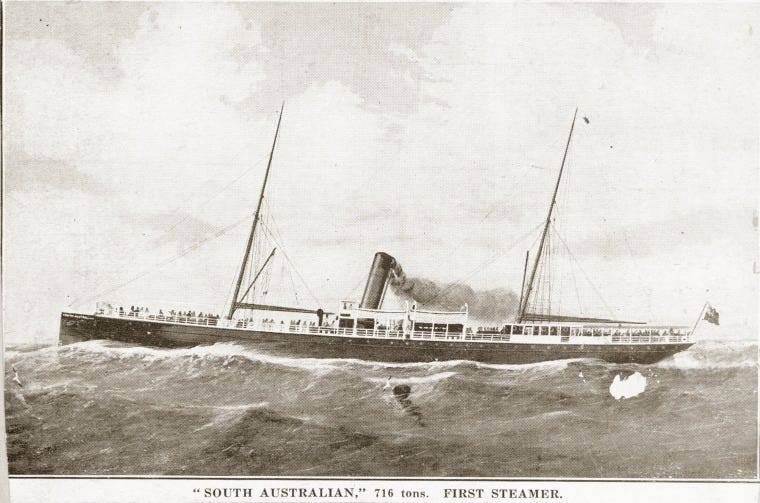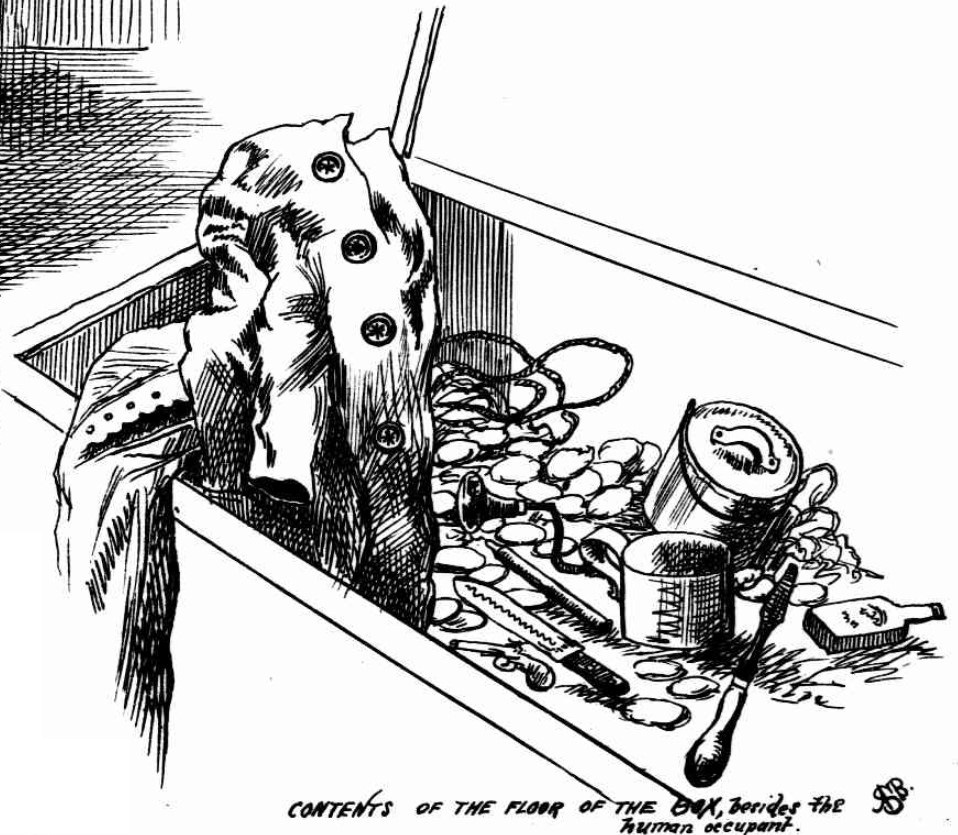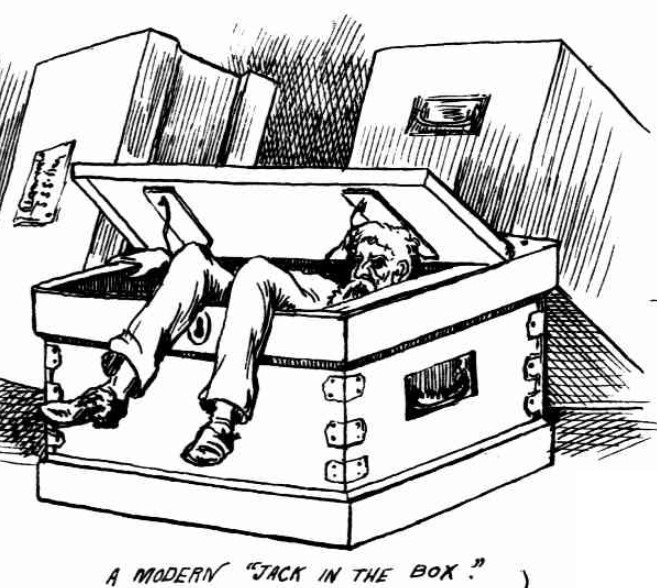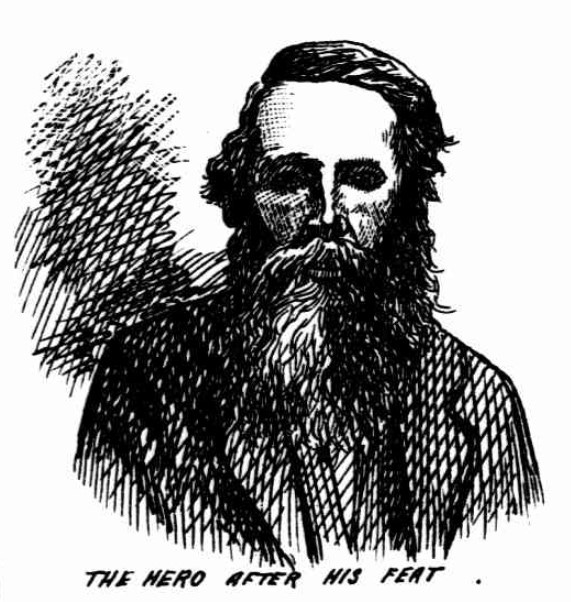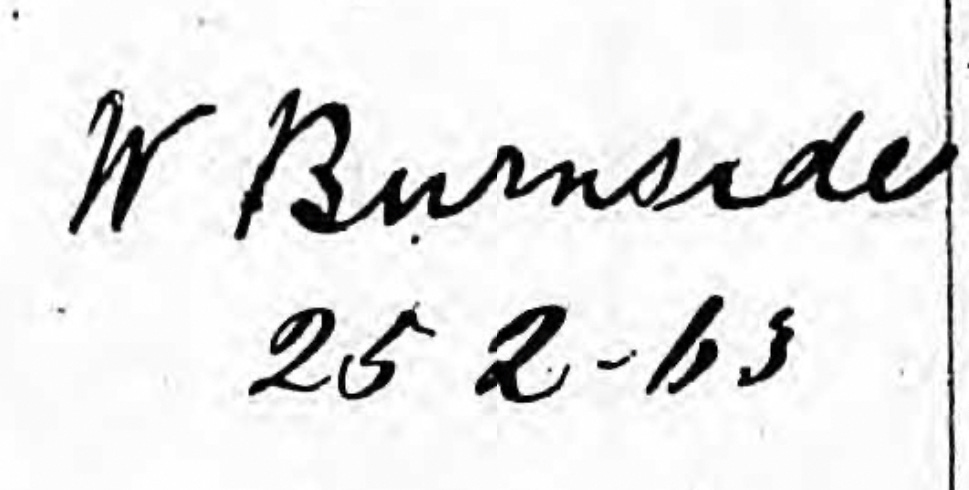After eight days at sea, the steamship ‘South Australian’ arrived at Port Adelaide on 8 October 1885. Passengers disembarked, and luggage and cargo soon followed. One of the boxes, three feet six inches long, two feet wide, and two feet one inch high, was labelled ‘Mr. Walter Biles, passenger per South Australian to Adelaide.’
The box was removed from the luggage hold and placed on the wharf. For half an hour, it sat awaiting transportation to the railway station. Customs Officer Walter Wadlow eyed it with suspicion. Just as it was about to be loaded onto the back of a dray, he ordered that it be investigated.
The carriers removed the cords, and the lid opened easily. Unlike the contraband they may have been expecting to find, they instead saw a “tall, lank, and grizzly bearded man, whose first words were ‘Give me a drink!’”
The discovery of a person inside the box resulted in a “general stampede” to witness the spectacle. The man found the strength to sit up and accepted some brandy and water. Dr James Matthews, a passenger aboard the vessel, examined him. All the while, the man was peppered with questions. When asked, he gave the name William Alderson. He was placed on board at Fremantle and refused to state by whom.
The contents of the box indicated how he had survived in such a confined space. Swallow & Ariell branded ship’s biscuits littered the bottom, the remains of sustenance he brought for the voyage. A rolled-up pea coat acted as a makeshift pillow. Additional items included: a revolver and cartridges, a small saw, a pannikin, a screwdriver, auger and bits, a chisel, matches, a candle, tobacco, a small bottle of oil, a crape veil, and an empty billy.
The lock was found in the bottom of the box, and two ropes were attached to the underside of the lid. He kept it closed by tying the ropes securely to nails. At some point, he used the auger to drill holes for ventilation.
Once Dr Matthews confirmed that Alderson was well enough, he was handed over to the police and taken to the Port Adelaide Police Station for further questioning. At the station, he asked for more water. He was instead given a pannikin of milk and bread and instructed to eat it by the spoonful. After so long without food, care was taken that he was not overfed.
Parts of the story slowly emerged. Despite the box being addressed to Walter Biles, it was to be delivered to a butcher in Bowden, South Australia. Walter at first denied having any knowledge of Alderson before admitting that he had worked with him in a railway gang.
Alderson was nearly six feet tall and looked over 40 years old. He claimed he made the box himself. He paid a man £2 to help him, then, after a glass of ale at a hotel, he climbed into it at 11 am on 1 October in Perth. The box was transported to Fremantle on a cart and thrown onto the wharf. It was left on its side before being placed in a sling and loaded onto the ship.
For two days, he remained inside the box. Several other cases were piled on top and on the third day, he managed to remove them using his foot and the lid as a lever. He sat up and allowed his legs to hang over the edge. The time to stretch was brief. Two sailors entered the hold to collect cargo. Alderson hurried back into the box and remained there for the rest of the journey.
He had a watch with him that he regularly wound, and he tried to look at the time using a candle. The heat from the flame was stifling. He had no water and barely ate any of the ship’s biscuits. Ship’s biscuits, or ‘hard tack,’ are meant to be moistened with liquid to make them edible. With no water at hand, they were hard and caused his tongue to stick to the roof of his mouth.
Concerned about his plight, at one point, he tried to attract attention by kicking the box. The ship’s engineer confirmed that he thought he heard banging but saw nothing amiss when he went to check.
As police looked through Alderson’s papers, it became clear he was not who he said he was. A former Western Australian who lived in Port Adelaide provided more information to a journalist. William Alderson was not the name of the man in the box. He knew him and his misdeeds well. His real name was William Burnside, and he was a convict.
…he has been in shooting affrays and other desperate work, and altogether has a very bad record.
Burnside was convicted of shooting with intent to kill on 21 July 1857 in Durham, England. He was sentenced to 14 years’ transportation and arrived in Fremantle aboard the ‘Merchantman’ on 14 February 1863. He was granted a Ticket of Leave a month later and a Conditional Pardon in 1871. From 1872 onwards, his criminal record listed offences such as horse stealing, burglary, housebreaking, and escape attempts. He was re-convicted as a colonial convict and received multiple prison sentences, including 14 years in 1878.
Dr John Toll arrived at the police station and examined him. Judging by his health, it was clear that he had scarcely left the box. Burnside continued to demand something to drink. Much to his relief, Dr Toll allowed him a bottle of ale. By midday, he had regained some of his strength.
Sub-Inspector John Doyle charged Burnside with travelling from Fremantle to Port Adelaide without paying his fare. In front of a crowd of curious onlookers, he appeared in the Port Adelaide Police Court on 12 October and pleaded not guilty. His solicitor argued that as he did not receive passenger comforts and the steamer carried no passengers’ certificate, technically, he was not a passenger. The argument was unsuccessful. Burnside was found guilty and was fined £1 and 30 shillings costs.
Burnside’s court time was far from over. Newspaper reports indicated that if confirmed to be a convict, he would be charged under Clause 2 of the Convicts Prevention Act of 1865. Under the Act, convicts were not permitted to land in South Australia unless they could prove that they had been free for at least three years. Without proof, they faced three years’ hard labour in South Australia or would be sent back to Western Australia.
The evils that he knew not of - three years’ imprisonment with hard labour - the evils that he might have guessed at - the incarceration in a small case for over a week - should surely have overbalanced the evil from which he fled - police supervision in Western Australia.
Burnside appeared in the Port Adelaide Police Court for the second time on 15 October 1885. The police charged him with being an offender illegally at large. Giving evidence for the prosecution was Constable Walter Randall. He was a member of the Western Australian Police Force before moving to South Australia.
Constable Randall knew Burnside well. He was stationed at Fremantle in July 1879 when a report arrived advising that Burnside and another man had escaped from Fremantle Prison. He was involved in the search and the arrest. Burnside was sentenced to three years’ imprisonment for escaping.
When questioned by the Court, Burnside referred to his record, and implied that the charges and punishments he received were unjust. He also expressed his utter frustration at being unable to leave once the sentence was served. It was for that reason that he escaped.
When a man had finished his sentence they would not let him go, and it was time a man got away somehow.
Sub-Inspector Doyle sought a seven-day remand, and the Court granted it. When they returned on 22 October, he had a telegram from the Western Australian police. They advised that a constable would arrive in Port Adelaide on 24 October and that they should hold Burnside until then.
Contrary to reports that the Western Australian police sent a constable, they actually sent Detective John Connor. He left Fremantle on 17 October via the steamship ‘Franklin’ and arrived in Port Adelaide on the 24th. Detective Connor appeared in the Port Adelaide Police Court on the same day. He produced a warrant and confirmed that Alderson alias Burnside was the man in it.
Burnside’s record was put forward, showing he was still under sentence in Western Australia. His presence in South Australia was contrary to the Act. As there was no steamship due to travel west anytime soon, Sub-Inspector Doyle requested another remand for 14 days.
Meanwhile, Burnside had become a minor celebrity in South Australia. One newspaper headline announced: “Remarkable Importation at Port Adelaide. The Customs Dumbfounded. Ticket-of-Leave Man Eight Days in a Box.” The Adelaide Observer printed a poem, while The Pictorial Australian, full of admiration for the ‘Wonderful Instance of Physical Endurance,’ arranged for their artist to draw a series of pictures. The sketches (some used throughout this story) depicted Burnside’s journey from Fremantle to Port Adelaide in a box.
To Bill-in-the-Box How didst thou fare, my foolish stowaway, When on the rolling ocean thou wast tossed, And wished thou wer’t not such a flat to go away Packed in a box, with chance of being lost? Thou didst forget, the better still to bear The ills of sickness on the ocean’s bed, To deck the lid with “this side up with care,” And so thou oft didst stand upon thy head.
While Burnside awaited deportation to Western Australia, he acted as a witness for the South Australian police’s case against Walter Biles. On 10 November, Sub-Inspector Doyle charged him with unlawfully concealing Burnside, a convict illegally at large. Walter claimed that he did not know he was in the box. Burnside gave evidence contradicting him.
I know the defendant, and know him only too well. In June last I was working on the railway at Perth, and the defendant came and stayed in my tent until early in September, when he left, taking with him the box produced.
Burnside had long been thinking about how to escape Western Australia. He claimed that Walter was the man who helped him.
I had often thought over the matter and on September 26 I had a conversation with Biles about stowing me away. The defendant promised to do the job for me, and I gave him £2, paid his passage-money £7 10s., and made him a present of a single-barrel gun.
Walter was also supposed to continue to help Burnside once the ship departed, but he failed to do so.
He promised to supply me with water on the passage round, but he did not, neither did he send anybody.
Regardless of Burnside’s testimony, the Magistrate deemed the case incomplete. He dismissed the charges, and Walter escaped without any consequences for his part in the scheme.
On 14 November 1885, the steamer ‘Franklin’ departed South Australia. On board and under guard was Burnside. He arrived in Western Australia four days later and was brought before the Perth Police Court on 23 November.
In scenes reminiscent of those at Port Adelaide, a large crowd awaited his arrival. The face they glimpsed looked pallid and careworn, and journalists speculated that perhaps he had not recovered from his ordeal. Also appearing in court was the box, still in the same condition as when it arrived in South Australia. Such was the fascination with it an Adelaide showman had offered to buy it for £20.
The report of Burnside’s unpleasant experience evoked sympathy from the Magistrate. He sentenced him to the minimum possible punishment, which many remarked seemed too harsh: 12 months’ imprisonment in irons. The general consensus was that what he had endured in the box was more than enough.
Rumours that a petition would be put forward to the Governor requesting clemency amounted to nothing. Burnside would remain imprisoned. By December, there was no more exciting news about the convict stowaway. Such was the lack of information a journalist felt compelled to report that police had uncovered where Burnside bought his biscuits.
So much for Mr. Burnside; he came out of darkness into the light of day; for a little while attention was turned towards him, and he became notorious because of his extraordinary attempt to become a free man.
Burnside never left Western Australia again. He continued to re-offend, and lived a reclusive life at a camp in the Darling Ranges. Near that camp in April 1895, he attempted to shoot Jacob Hawter. He was brought before Justice Edward Stone in the Supreme Court, who remarked, “…it is very strange that at your time of life, after so many years have passed over your head since you were found guilty of a similar offence and sentenced to fourteen years penal servitude, you should again be attempting to commit the same offence.”
Justice Stone sentenced him to eight years penal servitude. One month into his sentence at Fremantle Prison, Burnside attempted to escape. He was punished with one month in solitary confinement. It was not until 10 April 1901 that the remainder of his sentence was remitted, and he was discharged.
Aged in his late 70s, William Burnside lived quietly for the rest of his life. He eventually moved to Subiaco, where he died on 19 November 1909. He was buried at Karrakatta Cemetery and today lies in an unmarked grave.
Though not for want of trying, William never truly regained freedom from a system that required absolute acquiescence and punished him with weeks of solitary confinement and, at times, a diet of bread and water. Ironically, and no doubt unintentionally on the part of prison authorities, that treatment was most likely how he managed to endure eight days at sea in a box.
Sources:
1885 'REMARKABLE IMPORTATION AT PORT ADELAIDE.', Evening Journal (Adelaide, SA : 1869 - 1912), 8 October, p. 2. (SECOND EDITION), viewed 26 Feb 2023, http://nla.gov.au/nla.news-article199137086
1885 'A STOWAWAY IN A BOX FOR EIGHT DAYS.', South Australian Register (Adelaide, SA : 1839 - 1900), 9 October, p. 6. , viewed 02 Mar 2023, http://nla.gov.au/nla.news-article44535283
1885 'From Fremantle to Adelaide in a Wooden Box.', The Express and Telegraph (Adelaide, SA : 1867 - 1922), 9 October, p. 3. (Afternoon Edition.), viewed 02 Mar 2023, http://nla.gov.au/nla.news-article208368252
1885 'FROM FREMANTLE TO ADELAIDE IN A WOODEN BOX.', The South Australian Advertiser (Adelaide, SA : 1858 - 1889), 9 October, p. 7. , viewed 02 Mar 2023, http://nla.gov.au/nla.news-article36314958
1885 'An Interview.', The Express and Telegraph (Adelaide, SA : 1867 - 1922), 8 October, p. 2. (Afternoon Edition.), viewed 26 Feb 2023, http://nla.gov.au/nla.news-article208368151
1885 'THE STOWAWAY FROM WESTERN AUSTRALIA,', Evening Journal (Adelaide, SA : 1869 - 1912), 12 October, p. 2. (SECOND EDITION), viewed 06 Mar 2023, http://nla.gov.au/nla.news-article199137337
1885 'THE STOWAWAY.', Evening Journal (Adelaide, SA : 1869 - 1912), 13 October, p. 2. (SECOND EDITION), viewed 06 Mar 2023, http://nla.gov.au/nla.news-article199137371
1885 'Law and Criminal Courts.', Evening Journal (Adelaide, SA : 1869 - 1912), 15 October, p. 2. (SECOND EDITION), viewed 08 Mar 2023, http://nla.gov.au/nla.news-article199137546
1885 'Police Court—Port Adelaide.', The Express and Telegraph (Adelaide, SA : 1867 - 1922), 22 October, p. 2. (Afternoon Edition.), viewed 08 Mar 2023, http://nla.gov.au/nla.news-article208368998
1885 'LITEST SHIPPING.', The Express and Telegraph (Adelaide, SA : 1867 - 1922), 24 October, p. 2. , viewed 09 Mar 2023, http://nla.gov.au/nla.news-article208369123
1885 'POLICE COURT— PORT ADELAIDE.', The South Australian Advertiser (Adelaide, SA : 1858 - 1889), 26 October, p. 6. , viewed 09 Mar 2023, http://nla.gov.au/nla.news-article36315943
1885 'WONDERFUL INSTANCE OF PHYSICAL ENDURANCE.', The Pictorial Australian (Adelaide, SA : 1885 - 1895), 1 November, p. 194. , viewed 09 Mar 2023, http://nla.gov.au/nla.news-article224541076
1885 'A WONDERFUL VOYAGE.', The Pictorial Australian (Adelaide, SA : 1885 - 1895), 1 November, p. 196. , viewed 09 Mar 2023, http://nla.gov.au/nla.news-article224541066
1885 'A WONDERFUL VOYAGE.', The Pictorial Australian (Adelaide, SA : 1885 - 1895), 1 November, p. 196. , viewed 10 Mar 2023, http://nla.gov.au/nla.news-article224541066
1885 'POLICE COURT—PORT ADELAIDE.', The Express and Telegraph (Adelaide, SA : 1867 - 1922), 11 November, p. 5. (Afternoon Edition.), viewed 11 Mar 2023, http://nla.gov.au/nla.news-article208370114
1885 'NEWS OF THE DAY.', The Daily News (Perth, WA : 1882 - 1955), 23 November, p. 3. , viewed 11 Mar 2023, http://nla.gov.au/nla.news-article76479831
1885 'General News.', The Inquirer and Commercial News (Perth, WA : 1855 - 1901), 2 December, p. 3. , viewed 11 Mar 2023, http://nla.gov.au/nla.news-article66037729
1885 'NEWS AND NOTES.', The West Australian (Perth, WA : 1879 - 1954), 15 December, p. 3. , viewed 11 Mar 2023, http://nla.gov.au/nla.news-article3004982
1895 'SUPREME COURT.—CRIMINAL SITTINGS.', The West Australian (Perth, WA : 1879 - 1954), 4 July, p. 3. , viewed 12 Mar 2023, http://nla.gov.au/nla.news-article4537936
1885 'NEWS AND NOTES.', The West Australian (Perth, WA : 1879 - 1954), 15 December, p. 3. , viewed 11 Mar 2023, http://nla.gov.au/nla.news-article3004982
1885 'TO BILL-IN-THE BOX.', Adelaide Observer (SA : 1843 - 1904), 17 October, p. 16. , viewed 15 Mar 2023, http://nla.gov.au/nla.news-article160744964
State Records Office of Western Australia; Perth, Australia; Convict Records; Description: Receipts and Discharges (Fremantle), 1897 - 1902 (Rd13a - Rd13b)
State Records Office of Western Australia; Perth, Australia; Convict Records; Description: Prisoners Property Book, 1861 - 1865 (V14)
State Records Office of Western Australia; Perth, Australia; Convict Records; Description: General Register for Various Nos 3844-10604 (R23)


